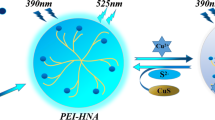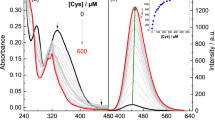Abstract
The detection of important biological thiols such as cysteine (Cys) is highly relevant to a variety of fundamental physiological processes in organisms. A conjugated polymer with pendant aldehyde group, which was used for reactive site for Cys, was synthesized via Suzuki coupling polymerization and the polymer was immobilized on the surface of amine-functionalized silica nanoparticles. The conjugated polymer-modified silica nanoparticles could be dispersed in alcoholic media, exhibiting various emission colors according to the alcoholic media, presumably due to the various polarity of the alcohols used. The organic–inorganic hybrid showed changes in emission color upon exposure to Cys with high selectivity over other amino acids, because of the specific reaction of aldehyde in the polymer and aminothiol group in Cys.






Similar content being viewed by others
References
Kim YG, Kim SK, Kwon JW, Park OJ, Kim SG, Kim YC, Lee MG (2003) Effects of cysteine on amino acid concentrations and trans sulfuration enzyme activities in rat liver with protein-calorie malnutrition. Life Sci 72:1171–1181
Yang X, Guo Y, Strongin RM (2011) Conjugate addition/cyclization sequence enables selective and simultaneous fluorescence detection of cysteine and homocysteine. Angew Chem Int Ed 50:10690–10693
Berberich JA, Yang LW, Madura J, Bahar I, Russell AJ (2005) A stable three–enzyme creatinine biosensor. 1. Impact of structure, function and environment on PEGylated and immobilized sarcosine oxidase. Acta Biomater 1:173–181
Zhao C, Qu K, Song Y, Xu C, Ren J, Qu X (2010) A reusable DNA single-walled carbon-nanotube-based fluorescent sensor for highly sensitive and selective detection of Ag+ and cysteine in aqueous solutions. Chem Eur J 16:8147–8154
Dalle-Donne I, Rossi R, Giustarini D, Colombo R, Milzani A (2007) S-glutathionylation in protein redox regulation. Free Radic Biol Med 43:883–898
Guo Y, Yang X, Hakuna L, Barve A, Escobedo JO, Lowry M, Strongin RM (2012) A fast response highly selective probe for the detection of glutathione in human blood plasma. Sensors 12:5940–5950
Zheng H, Zhan XQ, Biana QN, Zhanga XJ (2013) Advances in modifying fluorescein and rhodamine fluorophores as fluorescent chemosensors. Chem Commun 49:429–447
Wang H, Zhou G, Gaib H, Chen X (2012) A fluorescein-based probe with high selectivity to cysteine over homocysteine and glutathione. Chem Commun 48:8341–8343
Timur S, Odaci D, Dincer A, Zihnioglu F, Telefoncu A (2008) Biosensing approach for glutathione detection using glutathione reductase and sulfhydryl oxidase bienzymatic system. Talanta 74:1492–1497
Jang G, Seo S, Lee TS (2015) Electrostatically self-assembled microcapsule composed of conjugated polyelectrolytes and polypeptides for an emission color-changeable assay for trypsin. Sens Actuators B Chem 221:1229–1235
Lee K, Povlich LK, Kim J (2007) Label-Free and Self-signal amplifying molecular DNA sensors based on bioconjugated polyelectrolytes. Adv Funct Mater 17:2580–2587
Liu Z, Wang HL, Cotlet M (2014) Energy transfer from a cationic conjugated polyelectrolyte to a DNA photonic wire: toward label-free, sequence-specific DNA sensing. Chem Mater 26:2900–2906
Kim D, Jang G, Kim J, Seo S, Park WH, Lee TS (2012) Cobalt ion-mediated cysteine detection with a hyperbranched conjugated polyelectrolyte as a new sensing platform. Macromol Rapid Commun 33:1510–1516
Lv F, Feng X, Tang H, Liu L, Yang Q, Wang S (2011) Development of film sensors based on conjugated polymers for copper (II) ion detection. Adv Funct Mater 21:845–850
Chen Y, Pu KY, Fan QL, Qi XY, Huang YQ, Lu XM, Huang W (2009) Water-soluble anionic conjugated polymers for metal ion sensing: effect of interchain aggregation. J Polym Sci Part A Polym Chem 47:5057–5067
Bao Y, Wang T, Li Q, Du F, Bai R, Smet M, Dehaen W (2014) An amphiphilic conjugated polymer as an aggregation-based multifunctional sensing platform with multicolor fluorescence response. Polym Chem 5:792–798
Jung HS, Chen X, Kim JS, Yoon J (2013) Recent progress in luminescent and colorimetric chemosensors for detection of thiols. Chem Soc Rev 42:6019–6031
Jang G, Kim J, Kim D, Lee TS (2015) Synthesis of triphenylamine-containing conjugated polyelectrolyte and fabrication of fluorescence color-changeable, paper-based sensor strips for biothiol detection. Polym Chem 6:714–720
Li J, Tian C, Yuan Y, Yang Z, Yin C, Jiang R, Song W, Li X, Lu X, Zhang L, Fan Q, Huang W (2015) A water-soluble conjugated polymer with pendant disulfide linkages to PEG chains: a highly efficient ratiometric probe with solubility-induced fluorescence conversion for thiol detection. Macromolecules 48:1017–1025
Kwon NY, Kim D, Jang G, Lee JH, So JH, Kim CH, Kim TH, Lee TS (2012) Highly selective cysteine detection and bioimaging in zebrafish through emission color change of water-soluble conjugated polymer-based assay complex. ACS Appl Mater Interfaces 4:1429–1433
Atchison N, Fan W, Brewer DD, Arunagirinathan MA, Hering BJ, Kumar S, Papas KK, Kokkoli E, Tsapatsis M (2011) Silica nanoparticle coatings by adsorption from lys–sil sols on inorganic and biological surfaces. Angew Chem Int Ed 50:1617–1621
Mahtab F, Yu Y, Lam JWY, Liu J, Zhang B, Lu P, Zhang X, Tang BZ (2011) Fabrication of silica nanoparticles with both efficient fluorescence and strong magnetization, and exploration of their biological applications. Adv Funct Mater 21:1733–1740
Lei J, Wang L, Zhang J (2010) Ratiometric pH sensor based on mesoporous silica nanoparticles and Förster resonance energy transfer. Chem Commun 46:8445–8447
Burns A, Sengupta P, Zedayko T, Baird B, Wiesner U (2006) Core/Shell fluorescent silica nanoparticles for chemical sensing: towards single-particle laboratories. Small 2:723–726
Slowing II, Trewyn BG, Giri S, Lin VSY (2007) Mesoporous silica nanoparticles for drug delivery and biosensing applications. Adv Funct Mater 17:1225–1236
Zhang ZG, Zhang KL, Liu G, Zhu CX, Neoh KG, Kang ET (2009) Triphenylamine–fluorene alternating conjugated copolymers with pendant acceptor groups: synthesis, structure–property relationship, and photovoltaic application. Macromolecules 42:3104–3111
Yang Z, Zhao N, Sun Y, Miao F, Liu Y, Liu X, Zhang Y, Ai W, Song G, Shen X, Yu X, Sun J, Wong W-Y (2012) Highly selective red- and green-emitting two-photon fluorescent probes for cysteine detection and their bio-imaging in living cells. Chem Commun 48:3442–3444
Zhang H, Wang P, Yang Y, Sun H (2012) A selective fluorescent probe for thiols based on α, β-unsaturated acyl sulfonamide. Chem Commun 48:10672–10674
You QH, Chan PS, Chan WH, Hau SCK, Lee AWM, Mak NK, Makc TCW, Wong RNS (2012) A quinolinyl antipyrine based fluorescence sensor for Zn2+ and its application in bioimaging. RSC Adv 2:11078–11083
Arraez-Roman D, Fernandez-Sanchez JF, Ramirez SC, Segura-Carretero A, Fernandez-Gutierrez A (2006) A simple light-emitted diode-induced fluorescence detector using optical fibers and a charged coupled device for direct and indirect capillary electrophoresis methods. Electrophoresis 27:1776–1783
Acknowledgments
Financial support from the National Research Foundation of Korea (NRF) funded by Korean Government through the Nuclear R&D Project (2015M2A7A1000217) is gratefully acknowledged.
Author information
Authors and Affiliations
Corresponding author
Rights and permissions
About this article
Cite this article
Jang, G., Lee, T.S. Conjugated polymer-hybridized silica nanoparticle as a fluorescent sensor for cysteine. Polym. Bull. 73, 2447–2456 (2016). https://doi.org/10.1007/s00289-016-1672-9
Received:
Revised:
Accepted:
Published:
Issue Date:
DOI: https://doi.org/10.1007/s00289-016-1672-9




